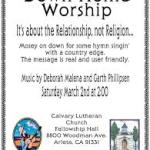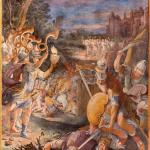INTRODUCTION
In Jesus?Eparables, the evangelistic invitation is often an invitation to a feast, a royal banquet (?the kingdom of heaven is like a king who gave a wedding feast . . . .?E. Christian liturgy is an enactment of that invitation and our response to it. In the call to worship, we are invited to draw near into God?s house. At the door, we confess our unworthiness, beg for cleansing and forgiveness, and receive assurance of pardon. Then we go up into the inner chambers of the Lord?s house, where He speaks kindly to us, promising us all good things in Christ and reminding us of the protocols of conduct we must observe as the family that gathers at His table. Finally, we come to the climax of the whole process, as we sit at His table to eat and drink in His presence. After purification and ascension, we receive a share in the peace offering; having been at the top of Sinai to hear the Lord?s voice, we ascend to eat and drink. And He does not stretch out His hand against us.
REPONSE TO WORD
Between the sermon and the Eucharist, we have a number of events/actions that represent our response to the Word of God. Here is what it looks like in the Trinity liturgy:
Pastoral Prayer
Lord?s Prayer
Passing of the Peace
Minister The Peace of the Lord be always with you.
People And with your spirit.
The people exchange peace and place offerings in the basket or box at the rear of the church.
Minister Behold how good and how pleasant it is for brethren to dwell together in unity.
People Amen.
(the people shall sit)
Offertory Service Booklet # 12
Prayers of the People
First, a definition or two. By ?pastoral prayer,?Ewe mean simply the prayer following the sermon, during which the preacher asks the Lord to confirm the word preached in the lives of the hearers. This is an acknowledgement that the Word of God does not come with persuasive rhetoric, but has its effect only when empowered by the Spirit. The prayer prior to the sermon asks the Spirit to illuminate the text and enlighten our minds to the text of Scripture; the prayer after the sermon asks the Spirit to use the words spoken in the sermon to convict, exhort, rebuke, comfort, and strengthen. By ?prayers of the people,?Ewe mean an intercessory prayer offered by the pastor, an elder, or by a ministerial candidate. This is the main intercessory prayer of the service.
Second, we have placed the offertory after the sermon, as the climax of the ascension. Our offering of tithes and gifts matches the tribute offering in the OT sacrificial ritual. Both express our acknowledgement of God?s Lordship, the fact that all we have is only gift, that we have nothing that we have not received. In the OT system, the tribute (or ?grain?E offering was given along with the ascension. At the conclusion of his instructions for the ordination of priests in Exodus 29, Moses describes the ?continuous?E(tamid) ascension offering that is to burn upon the altar. Both the morning and evening ascensions are to be accompanied by ?an ephah of fine flour mixed with one-fourth of a hin of beaten oil, and one-fourth of a hin of wine for a libation with one lamb?E(Exodus 29:41). Similarly, Numbers 28 lists not only the prescribed animal offerings for daily, Sabbath, and festival sacrifices, but also the accompanying grain offerings and libations. Leviticus 9:4 may indicate that grains offerings could also accompany the peace offerings, but the bulk of the evidence from the sacrificial system associates the tribute with the ascension. The logic thus is this: Having ascended into Yahweh?s presence and heard the word of promise and command, we respond by acknowledging the Lord?s Lordship by giving our tithes and offerings. When we have acknowledged the enthroned king, we are invited to come to His table. To underscore the fact that the gifts we give are part of a whole-self offering, we sing a portion of Psalm 51 (?The sacrifices of God are a broken and contrite heart?E?E as the deacons bring forward the offering.
In some historic liturgies, the offertory has been much more elaborate, and has been associated with the Eucharist rather than with the liturgy of the Word. In some liturgies, the Eucharistic elements are brought forward at the same time as the gifts of the people, so that the gifts of the people are folded into the Eucharistic action. As Gregory Dix explains it, ?Each communicant from the bishop to the newly confirmed gave himself under the forms of bread and wine to God, as God gives Himself to them under the same forms. In the united oblations of all her members the Body of Christ, the church, gave herself to become the Body of Christ, the sacrament, in order that receiving again the symbol of herself now transformed and hallowed, she might be truly that which by nature she is, the Body of Christ, and each of her members members of Christ. In this self-giving the order of laity no less than that of the deacons or the high-priestly celebrant had its own indispensable function in the vital act of the Body.?EThus, ?The offertory in the original view of the rite is therefore something much more than a ceremonial action, the placing of bread and wine upon the altar by the clergy as an inevitable preparation for communion. It is as the later liturgies continued to call it ?Eeven when it had lost all outward signs of its primitive meaning ?Ethe ?rational worship?Eof free reasonable creatures of their Creator, a self-sacrificial act by which each Christian comes to his being as a member of Christ in the ?re-calling?Ebefore God of the self-sacrificial offering of Christ on Calvary.?EThe bringing of gifts in connection with the bringing of the Eucharistic elements thus manifested Augustine?s notion that the church is ?upon the table?Eand ?in the chalice.?EDix goes on to say that the earliest liturgies, ?this self-offering was expressed by action in the offertory, simply by the silent setting of the church?s offerings by the church?s servants (the deacons) upon the altar, which in the early symbolism was itself thought of as representing Christ.?E
Though the practice of including the presentation of tithes and gifts with the presentation of the Eucharistic elements captures one side of the Eucharistic rite (we are ?further engaged?Eto service to God in the Supper, cf. WCF 29.1), at Trinity we have not joined the presentation of offerings directly to the Eucharist. The main reason has to do with the concern that this might inadvertently communicate a false notion of the Supper. Making the offertory integral to the Supper might undermine the basic Reformation insight that the Supper is a gift of God to His people, rather than a work that we perform for God?s favor. Properly understood, of course, our self-offering is a response to God?s prior gift, and indeed our self-offering is itself a gift (since we can?t do it except by the Spirit). Yet, to avoid misunderstanding, we placed the presentation of offerings with the liturgy of the Word.
Third, practically, we don?t pass a plate. Instead, we have a basket for offerings available at the beginning of the service, and the congregation is also able to take their offerings to the basket during the passing of the peace, when members greet each other with a handshake, a kiss, a hug, and words like ?The Lord be with you/And with you.?EIn addition to the practical function of allowing the congregation a change to drop their offerings into the basket, the passing of the peace, at the hinge between the Word and Supper, plays two liturgical roles. It manifests the peace that we have with one another in Christ. The word that we have heard is the announcement of the gospel of peace, the gospel that breaks down the dividing wall and makes peace, the gospel of reconciliation, the gospel of peace on earth. In response, we symbolize our peaceableness by passing the peace of Christ to one another. Further, this exchange of greetings and peace is preparation for our movement to the Lord?s table. Through the passing of the peace,
we declare that we are at peace with one another; we reconcile with our brothers before coming to the ?altar?Eof the Lord?s table (Matthew 5:23-24). Paul condemned the Corinthian celebrations of the Supper precisely because they gathered in disunity, because they brought their divisions to the table of unity. Passing the peace does not prevent hypocrisy; we can be Judases who betray a brother while kissing him. But the passing of the peace points to our aspirations concerning the Supper, that we gather as brothers and sisters, as a unified family, at the table of our Father.
Finally, a few words about the prayers of the people. This, as I mentioned, is our main intercessory prayer of the service. For the most part, the elders or ministers who lead this prayer have written the prayer out ahead of time. Frequently, we use prayers from historic liturgies, with additions and adaptations to our circumstances (we rarely pray for the Queen of England, for instance). We have also made it a practice from the beginning of Trinity to include prayer for another local congregation each Sunday. A member of Trinity is in contact with various pastors in town, and gathers prayer requests for us to use. This is only a beginning, but it points to our desire to be catholic in our local area.
EUCHARIST
The Lord?s Supper has been called by many names, and each of them brings out a particular aspect of the infinitely rich event of the Supper. It is ?communion,?Ebecause in this meal we participate in the body and blood of Jesus, and commune together as a communion of saints, in a communion of holy things (1 Corinthians 10:16-17). It is ?Eucharist?Ebecause it includes an act of thanksgiving. It is ?Lord?s Supper?Ebecause it is a meal, a covenant meal that seals the renewal of the covenant between our Lord and us.
The following outline of our Eucharistic liturgy is not found in the bulletin, but comes from the ?officiant?s?Eliturgy that I use to lead the service:
GOD FEEDS US
Eucharistic Meditation
Thanksgiving for the Bread
In the night in which He was betrayed, Jesus took bread and gave thanks. Let us pray.
Thanksgiving
Blessed are You, Almighty God, Creator and King of heaven and earth, for You have provided bread to strengthen our hearts. Blessed are You, Almighty God, Father of our Lord Jesus, for You sent the true bread from heaven, even Jesus our Savior, to be life to us. Amen.
Having given thanks, He broke it and gave it to His disciples, saying, Take, Eat. This is My Body which is given for you. Do this in remembrance of Me.
Distribution and Hymn Cantus # 268
Eating
This is the body of Christ, given for you. Eat in faith, and receive it with joy and thanksgiving.
Cup
After the same manner also, after supper, Jesus took the cup, and gave thanks. Let us pray.
Thanksgiving
Blessed are You, Almighty God, Creator and King of Heaven and Earth, for You made wine to gladden the heart of man. Blessed are You, our Father in heaven, for You have given us this true wine, the blood of Your Son, for our joy and nourishment. Amen.
Offer
Having given thanks, Jesus gave the cup to His disciples, saying, This is the blood of the new covenant, which is shed for you and for many for the remission of sins. Drink of it all of you.
Distribution and Hymn Cantus # 224
Drinking
This is the blood of the new covenant, which is shed for you and for many for the remission of sins. All of you drink of it.
(the people shall stand)
Final Thanksgiving
Minister: Eternal God,
People join: Heavenly Father, You have graciously accepted us as living members of your Son our Savior Jesus Christ,
And you have fed us with spiritual food
In the Sacrament of his Body and Blood.
Send us now into the world in peace,
And grant us strength and courage to love and serve you
With gladness and singleness of heart;
Through Christ our Lord. Amen.
There is a lot to say here, too much for this brief summary. But let me point to some features of this liturgy. First, notice the sequence of actions here: Take bread, thanks, break, distribute, eat; then take cup, thanks, offer, distribute, drink. As James Jordan has pointed out, these actions replicate the actions of creation, when God took hold of the world, broke it into peaces, assigned it new names, and enjoyed what He had made. This is also the pattern for all human creation, all human poiesis. In the Eucharist, we are being re-trained for true creativity, which, for creatures, is always Eucharistic, grateful creativity.
Second, notice that the prayers are prayers of thanksgiving, not prayers of ?consecration?Eor requests that God ?set apart?Ethe elements from common to holy use. According to 1 Timothy 4:4-5, a kind of ?sanctification?Ehappens when we offer thanks, but Paul?s words there apply to our daily common meals as much as to the Eucharistic meal. Why a prayer of thanksgiving specifically? Several reasons: It?s what Jesus prayed at the Last Supper, and told us to ?do?E(Matthew 26:26; Mark 14:22; Luke 22:19; 1 Corinthians 11:24). The verb in Matthew and Mark is ?blessed?Erather than ?give thanks,?Ebut this points, as Louis Bouyer argued in his treatise on the Eucharistic prayer, to a particular form of thanksgiving, the ?berekah,?Ewhich blessed God for His gifts (cf. Genesis 14:20, and note context; 1 Samuel 25:32; Psalm 66:20; 68:35). The Eucharistic prayer is just a table prayer, a ?grace?Esaid to thank God for the food we are about to receive. The Lord?s Supper is a special meal, but it is a meal, and like all meals begins with thanks.
Third, there are two prayers rather than a single prayer that covers both bread and wine. This is the pattern in Matthew and Mark; Luke includes two cups of wine, but does include separate prayers for the first cup and for the bread. Paul in 1 Corinthians suggests that Jesus prayed only once. It would be going beyond the biblical evidence, I think, to demand that there be two prayers, but that is the pattern in the gospels at least. The main practical value of having two prayers is that it distinguishes the gift of bread from the gift of wine, and keeps in view their different significances. To cite James Jordan again, bread is ?Alpha food,?Ethe food of the beginning of the day; wine is ?Omega drink,?Ethe drink that we enjoy when the work is done (cf. Nazirites, Numbers 6). Bread is fuel for work; wine is given to gladden the heart satisfied with labor. Besides, the separation of bread and wine keeps in view the continuities between the Supper and the sacrificial rites of the OT. Though there are also obvious and crucial discontinuities, in both OT and NT the meal involves a separation of flesh and blood. In short, separation the prayers for bread and for wine emphasizes subtle aspects of the Supper that might otherwise be lost.
Fourth, the distribution of bread and wine is accompanied with song. This makes sense within the sacrificial system, in that song accompanied not only the ascension offering but the peace offering as well (cf. 2 Chronicles 29). This also manifests another important aspect of the Supper, that it is a moment of joy, not a time for mourning. In the Bible, God never, ever, ever, ever, ever, ever, ever, ever tells his people to lament as they come to a meal. Fasting is the gastronomical form of lamentation. Feasting is joyful, robust, boisterous. Our singing at communion should be triumphant, loud, fast, glad. We should sing until we are joyful, until we are drunk on the Spirit.
Finally, the whole congregation joins in the final thanksgiving. The Supper is Eucharist, not only because of the two Eucharistic prayers, but because of the final Eucharist, the final thanksgiving, for the privilege of receiving spiritual food at the Lord?s table. This prayer also points ahead to the dismissal, indicating that we are fed at the Lord?s table so that we can serve God and our neighbors with tireless energy in the coming week.
GET OUTTA HERE
Many Protestants shy away from the word ?Mass?Eas a description of the worship service, and for good reason. The word has become too entangled with false doctrine and practice to be easily stripped of its associations. Yet, in its etymological sense, it is quite proper to call the whole service a Mass. ?Mass?Ecomes from the final words of the Latin Mass, meaning, basically, ?Get outta here; you got work to do.?EThe service is a ?Mass?Ebecause it prepares us to be sent out into the world to minister in the name of the Lord.
In the Trinity liturgy, the dismissal looks like this:
DISMISSAL
Pastoral Charge
Benediction
Recession Nunc Dimittis Service Booklet # 13
Dismissal
Minister Go in peace, and the God of peace be with you.
People Amen.
Normally, I draw the pastoral charge from the sermon text, or from some other Scripture related to the sermon text. For a benediction, I use either the Aaronic benediction of Numbers 6 or, usually, a Trinitarian benediction (?The grace of our Lord Jesus Christ . . . .?E. The benediction is not a prayer, nor merely good wishes. It is a blessing, a pronouncement, a speech act that does what it says just as surely as the absolution does. Many of the Scripture passages used for benedictions thus are not particularly appropriate for the purpose (e.g., ?Now to Him who is able to keep you from stumbling . . . ?EJude 1:24), since they are prayers for blessing or thanksgivings to God rather than pronouncements of blessing on the people.
As the minister and elders process out, everyone sings the Nunc Dimittis, the ?Song of Simeon?Efrom Luke 2. It is a song of dismissal (in Simeon?s case, a dismissal from life), but also a song of mission, praising God for fulfilling His Word, sending salvation before our eyes, and shining a light upon the Gentiles. We are ready to be dismissed, to go in peace, led by the God of peace who is also our rear guard, to seek and promote the peace, the fullness of life, that is the kingdom of God.
CONCLUSION
We began the liturgy at the doorway of God?s house. He allowed us to enter, cleansed us, gave us assurance of His good favor, taught us, fed us, and now sends us out to tell of all that we have heard and seen, to enact in our lives all that we have heard and seen. Liturgy is not separated from life. It is preparation for life; God?s promises give us hope and His commands guide the steps of our feet, God?s food strengthens us to serve Him. But it is also the culmination of life; we work and live so that we can offer the fruits of our labor to God, so that we can bring our gifts (which we received from Him) to Him and receive them back from Him, transformed into the gifts of the kingdom. Worship is the beginning of our week; it is the end of our week. The liturgy is, like the Lord we serve, the frame of all time and all human life, the Alpha and the Omega, the beginning and the end.














